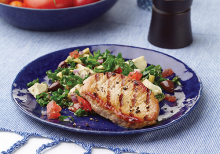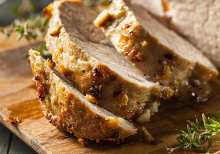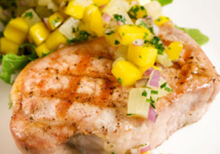Did you know that grilling is a diabetes-friendly cooking method? Cooking over an open flame doesn’t require adding any oil, and fat can drip off whatever you are cooking, making for a lower fat meal. Read on for more grilling tips from the National Pork Board and some of our favorite grilling recipes.
Diabetes-Friendly Grilling with Pork
April 2, 2025

Tips for Grilling Pork
- To prevent pork from sticking to the grate, scrub grates clean and coat with vegetable oil or a nonstick vegetable oil spray prior to using.
- Do not use sharp utensils that may pierce the pork when flipping, as piercing allows flavor-filled juices to escape. Use spatulas or tongs for turning.
- Frequently flipping pork on a cooler area of the grill is better than accidentally burning it on an area that is too hot.
- Sugar-based sauces (many commercial barbeque sauces) tend to burn if applied too early. Baste during the last few minutes of cooking.
- To check cooking temperature when using charcoal:
- Low – Ash coat is thick, red glow less visible
- Medium – Coals covered with light-gray ash
- High – Red glow visible through ash coating
Because pork cuts will cook differently depending on their size and thickness, it is important to monitor pork temperature with a digital thermometer when grilling.
Enjoy the best eating experience when cooking cuts such as pork chops and pork tenderloin between 145 degrees F. (medium-rare) and 160 degrees F. (well), with a 3-minute rest time after leaving the grill. Ground pork should always be cooked to 160 degrees F.
Recipes
Grilled Pork with Tomato, Artichoke, and Kale Salsa
Image

Grilled Pork Tenderloin with Peach Salsa
Image

Budget-Friendly Pork Chops with Peach Salsa
Image

Pork and Avocado Salad
Image






